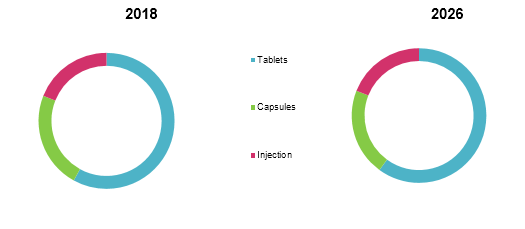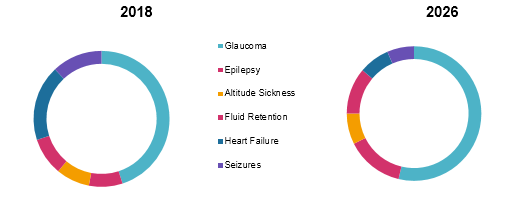Acetazolamide is carbonic anhydrase inhibitor, used in adjuvant treatment of chronic simple (open-angle) glaucoma, secondary glaucoma, and preoperatively in acute angle-closure glaucoma, epilepsy, edema due to congestive heart failure, drug-induced edema, and acute mountain sickness in climbers. Acetazolamide promotes acclimatization to altitude, increases bicarbonate secretion by the kidneys, induces metabolic acidosis, and stimulates ventilation. Furthermore, according to the BMJ Journal, September 2012, acetazolamide in doses of 250 mg, 500 mg, and 750 mg daily are more effective compared to placebo for preventing acute mountain sickness. In addition, acetazolamide 250 mg daily is the lowest effective dose to prevent acute mountain sickness.
The global acetazolamide market size was valued at US$ 183.2 Mn in 2017, and is expected to witness a CAGR of 4.8% during the forecast period (2018 – 2026).
Global Acetazolamide Market Share, By Formulation: 2018 & 2026

To learn more about this report, Download Free Sample
Source: Coherent Market Insights Analysis (2018)
Extended Application of Acetazolamide in Various Treatment Modalities is expected to Drive Market Growth during the Forecast Period
Acetazolamide is used to prevent high altitude illness in most people, which is characterized by headache, nausea, vomiting, and tiredness (often called acute mountain sickness), but may affect the brain or the lungs in different individuals. As per the study published in Cochrane Journal, in June 2017, acetazolamide is an effective and better treatment for the prevention of acute high altitude illness (HAI) in dosages of 250 to 750 mg/day, when compared to a placebo. Acetazolamide prevents acute mountain sickness and has fewer side effects than alternative drugs such as dexamethasone. According to BMJ journal, May 2018, prescribing acetazolamide for travel is an optional service and not included in the general practitioner’s contract in the U.K.
Researchers at the University of Chicago investigated acetazolamide, and published in the journal Science Translational Medicine, July 2018, stating that, altitude sickness drug, acetazolamide, helps to overcome resistance to chemotherapy drug temozolomide (TMZ). TMZ is frequently used in the treatment of gliomas, but some patients do not respond to the treatment. With the addition of acetazolamide, researchers identified an improvement in survival rates, in pre-clinical models of glioma. According to this study, acetazolamide when taken with TMZ, resulted in 30 to 40 percent increase in survival in animal models. Application of acetazolamide could be used as an alternative treatment solution for reducing resistance to chemotherapy in the treatment of gliomas, which offer lucrative growth opportunities for the drug in the market in the near future.
Furthermore, along with chronic simple (open-angle) glaucoma, secondary glaucoma and acute mountain sickness in climbers; acetazolamide is also indicated for adjective treatment of edema due to congestive heart failure; drug-induced edema; centrencephalic epilepsies.
Global Acetazolamide Market Share, By Application: 2018 & 2026

To learn more about this report, Download Free Sample
Source: Coherent Market Insights Analysis (2018)
Increasing Prevalence of Glaucoma among Global Population is expected to Aid in Market Growth
Increasing prevalence of glaucoma and associated risk factors such as high myopia, diabetes, eye surgery or injury, high blood pressure, increased usage of corticosteroids, and family history of glaucoma among the global population are expected to offer conducive future growth for acetazolamide drug manufacturers. As a sustained release capsule of Acetazolamide taken a day, offers a substantial pressure-lowering effect that lasts at least 23 hours. Treatment with acetazolamide helps to reduce eye pressure, which aids in preventing eye damage. Acetazolamide works by blocking the action of an enzyme called carbonic anhydrase thereby, reducing the amount of fluid secreted in the front part of eye, thus lowering eye pressure. For instance, according to the study published in the Journal of Ophthalmology (2014), an estimated 64.3 million people (aged 40-80 years) in 2013, were affected with glaucoma, which would increase to 76.0 million in 2020, and 111.8 million in 2040.
According to the International Agency for the Prevention of Blindness, 2017, glaucoma is the second leading cause of blindness and leading cause of irreversible blindness worldwide. With primary angle closure glaucoma (PACG) being the most common in South-East Asia while primary open-angle glaucoma (POAG) is mostly found among white Caucasians and individuals of Africa.
Among region, Asia Pacific is expected to be conducive region for the acetazolamide market growth. This is mainly owing to growing healthcare infrastructures, high prevalence of glaucoma, and associated risk factors such as diabetes and high blood pressure cases among the population of the region. For instance, according to American Academy of Ophthalmology (AAO), November 2013, glaucoma is the most common cause of preventable, irreversible blindness worldwide, among which primary open-angle glaucoma (POAG) is responsible for 12.3% of blindness. Furthermore, according to same source, POAG’s prevalence is estimated to be the highest among the people of China, intermediate in Japan, and lower in Europe and India. Therefore, these driving factors are expected to propel growth of acetazolamide market in Asia Pacific.
Key players operating in the acetazolamide market include Teva Pharmaceutical Industries Ltd., Accord Healthcare Ltd. (Intas Pharmaceuticals Limited), Heritage Pharmaceuticals Inc., Nostrum Laboratories Inc., Novast Laboratories Ltd., Cadila Healthcare (Zydus Pharmaceuticals (USA) Inc.), Lannett Company, Inc., Strides Shasun Limited, and X-GEN Pharmaceuticals, Inc.
Share
Share
Missing comfort of reading report in your local language? Find your preferred language :
Transform your Strategy with Exclusive Trending Reports :
Frequently Asked Questions
Select a License Type
Joining thousands of companies around the world committed to making the Excellent Business Solutions.
View All Our Clients